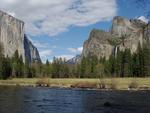Every year hundreds of thousands of people hike the trails on the Inyo National Forest. Have you ever thought about the work that goes into keeping this extensive trail system open?
We recently caught up with two backcountry trail crews from the California Conservation Corps (CCC) and Eastern Sierra Conservation Corps (ESCC). These crews work in close partnership with the Inyo National Forest in the backcountry during the summer and fall months. You may be able to find them anywhere from one to twenty miles from trailheads across the forest working to remove trees that have fallen across trails, build check dams and water bars to redirect water off trails, and reroute trails around unsafe or sensitive areas. The Inyo National Forest also employs professional trail crews and trail crew leaders to guide partners like the Pacific Crest Trail Association who also complete trail work on forest lands.
On July 1 we found the CCC crew cutting and moving logs, repairing water bars and re-routing a section of the John Muir Trail within the John Muir Wilderness north of Devils Postpile National Monument. The CCC Backcountry Trails Program have been partners with the Inyo for over 35 years.
“Spending six months living and working in the backcountry builds character, allows participants to develop unique skills and teaches them the value of getting along and being part of a community,” said Northern Inyo Trails Supervisor Keith Dawley. “The CCC program has been a major recruiting base for the forest. Some of our best employees have graduated from this program.”
For this particular project, the crew’s supplies were packed in by members themselves. For their next job near Shadow Lake their supplies will be brought in by pack stock. Pack mules will be carrying all of the crew’s tools, food, and camping gear and resupplying them weekly for the rest of the season.
On July 2 we hiked in on the Cottonwood Pass Trail in the Golden Trout Wilderness where we found the small but mighty trail crew from ESCC. This group of six strong individuals started just two weeks prior but they had already covered an impressive 100 miles of trails. ESCC Crew leader Hannah is proud of how far the crew has come in a very short period of time and their good work has caught the attention of Mt. Whitney District Wilderness Manager Calder Reid.
“I have never seen water bars cleaned so thoroughly and trails rocked so cleanly. I am really impressed by this crew’s work,” remarked Calder, who recently baked and delivered brownies to the crew.
In order for a crew such as this one to operate successfully, thoughtful planning on the part of Keith, Calder and the crew leaders is required. Every detail from water sources to the location of trees blocking trails are worked out before the crew heads into the wilderness, often in locations without cell phone reception.
Crews must also be trained in the use of many tools that help with the arduous work, including the crosscut saw. Crosscut saws are the preferred tool in designated federal Wilderness areas where chainsaws are prohibited. The crosscut is lighter and operates quietly, making it the perfect wilderness tool.
Trail crews also learn to set up rigging systems used for moving large objects, design the placement of check steps and water bars, move and rotate large trees into specific positions using log tongs, and move boulders using a large pry bar called a rock bar. Crews also learn to work as a team using common working vocabulary and hand signals and look out for each other’s safety.
ESCC Trail Crew Leader Hannah summed up the goal of her trail crew in one sentence, “The two pillars of trail maintenance are to keep people on and water off the trail."
Trail crews maintain and improve trails for all
All posts are those of the individual authors and the owner
of this site does not endorse them. Content should be considered opinion
and not fact until verified independently.
Sorry, only registered users may post in this forum.


